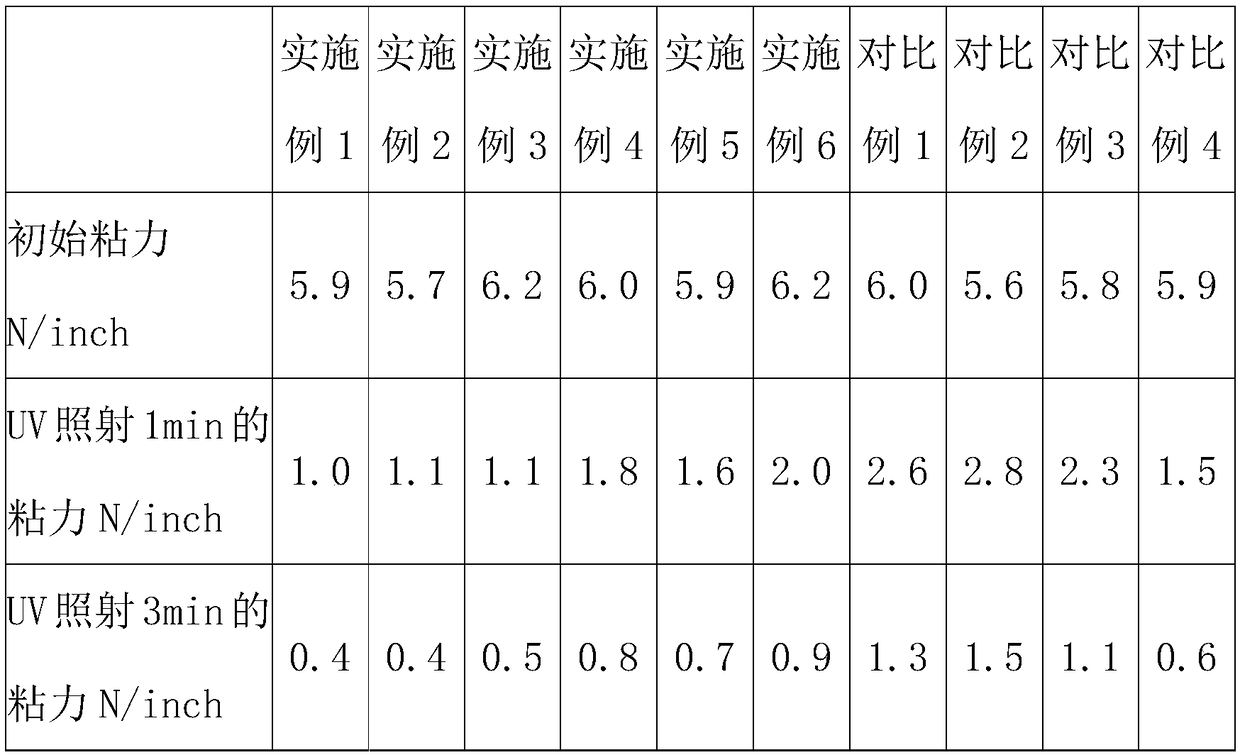Novel adhesive sticker with viscous force reduced after UV illumination and preparation method thereof
A new type of sticky technology, applied in the direction of adhesive types, ester copolymer adhesives, non-polymer adhesive additives, etc., which can solve the problems of high defect rate, high initial viscosity, and easy downtime.
- Summary
- Abstract
- Description
- Claims
- Application Information
AI Technical Summary
Problems solved by technology
Method used
Image
Examples
Embodiment 1
[0020] A new type of self-adhesive for reducing viscosity by UV light, which is characterized in that it includes a release backing paper and an outer adhesive layer, wherein the outer adhesive layer includes an acrylic pressure-sensitive adhesive with a molecular weight of 500,000-600,000 and an ultraviolet light area of 250 -420nm free radical photoinitiator and isocyanate, the thickness of the outer adhesive layer is 18-25um; the mass ratio of the acrylic pressure sensitive adhesive, isocyanate and free radical photoinitiator is 100:2.2:16; the release backing paper 80g glassine backing paper with release liner was used for coating.
[0021] The outer adhesive layer also includes a triarylsulfonium salt photoinitiator I-160, and the mass ratio of the triarylsulfonium salt photoinitiator I-160 to the free radical photoinitiator is 1.2:5. The free radical photoinitiator is a hydrogen abstraction type photoinitiator BP. The outer adhesive layer also includes nano-lanthanum ...
Embodiment 2
[0024] A new type of self-adhesive for reducing viscosity by UV light, which is characterized in that it includes a release backing paper and an outer adhesive layer, wherein the outer adhesive layer includes an acrylic pressure-sensitive adhesive with a molecular weight of 500,000-600,000 and an ultraviolet light area of 250 -420nm free radical photoinitiator and isocyanate, the thickness of the outer adhesive layer is 18um; the mass ratio of the acrylic pressure sensitive adhesive, isocyanate and free radical photoinitiator is 100:1.5:20; the release backing paper uses 80 grams of glassine backing paper with release function for coating.
[0025] The outer adhesive layer also includes a triarylsulfonium salt photoinitiator I-160, and the mass ratio of the triarylsulfonium salt photoinitiator I-160 to the free radical photoinitiator is 1:5. The free radical photoinitiator is a hydrogen abstraction type photoinitiator BP. The outer adhesive layer also includes nano-lanthanu...
Embodiment 3
[0028] A new type of self-adhesive for reducing viscosity by UV light, which is characterized in that it includes a release backing paper and an outer adhesive layer, wherein the outer adhesive layer includes an acrylic pressure-sensitive adhesive with a molecular weight of 500,000-600,000 and an ultraviolet light area of 250 -420nm free radical photoinitiator and isocyanate, the thickness of the outer adhesive layer is 25um; the mass ratio of the acrylic pressure-sensitive adhesive, isocyanate and free radical photoinitiator is 100:3:12; the release backing paper uses a 80 grams of glassine backing paper with release function for coating.
[0029] The outer adhesive layer also includes a triarylsulfonium salt photoinitiator I-160, and the mass ratio of the triarylsulfonium salt photoinitiator I-160 to the free radical photoinitiator is 1.5:5. The free radical photoinitiator is a hydrogen abstraction type photoinitiator BP. The outer adhesive layer also includes nano-lantha...
PUM
| Property | Measurement | Unit |
|---|---|---|
| Thickness | aaaaa | aaaaa |
| The average particle size | aaaaa | aaaaa |
| Thickness | aaaaa | aaaaa |
Abstract
Description
Claims
Application Information
 Login to View More
Login to View More - R&D
- Intellectual Property
- Life Sciences
- Materials
- Tech Scout
- Unparalleled Data Quality
- Higher Quality Content
- 60% Fewer Hallucinations
Browse by: Latest US Patents, China's latest patents, Technical Efficacy Thesaurus, Application Domain, Technology Topic, Popular Technical Reports.
© 2025 PatSnap. All rights reserved.Legal|Privacy policy|Modern Slavery Act Transparency Statement|Sitemap|About US| Contact US: help@patsnap.com

